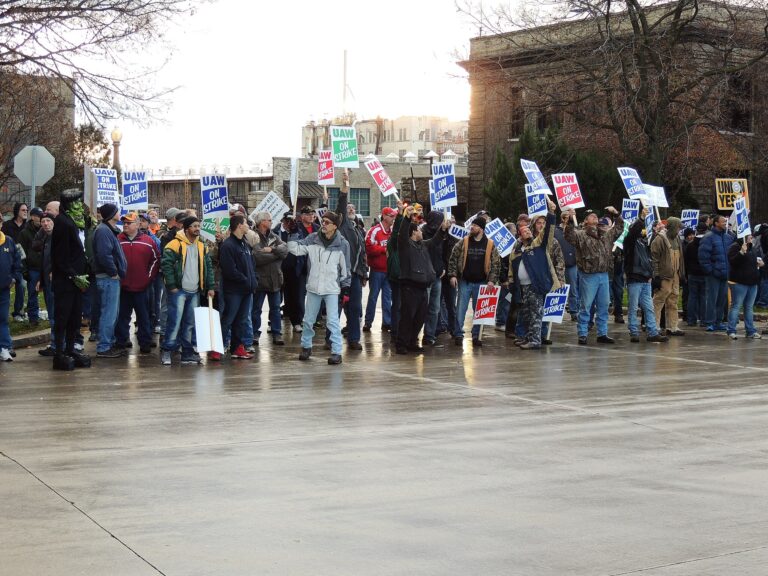
Leigh Thomas is a student at Harvard Law School.
Today, the Supreme Court held that Title VII prohibits workplace discrimination on the basis of sexual orientation and gender identity. The decision is an historic victory for LGBTQ advocates, arriving more than 45 years after the introduction of the first bill in Congress aimed at protecting LGBTQ workers. It also comes as the Trump administration has mounted new attacks on LGBTQ rights. Justice Gorsuch wrote for the majority, framing the decision as a “straightforward application of legal terms with plain and settled meanings.”
The Court begins its opinion by assessing the ordinary public meaning of the terms of Title VII. First, it assumes the employers’ definition of “sex”: “status as either male or female [as] determined by reproductive biology.” Second, it defines “because of” sex as simple “but-for” causation: an action is illegal if it would not have occurred but for sex, even if other causes were at play. Finally, it interprets discrimination to mean differential treatment of an individual employee, rather than a class. From these understandings, the Court articulates a clear rule: “An employer violates Title VII when it intentionally fires an individual employee based in part on sex.”
Next, the Court concludes that “it is impossible to discriminate against a person for being homosexual or transgender without discriminating against that individual based on sex.” It uses two examples drawn from the employees’ arguments. If a male and female employee are both attracted to men, but the employer only fires the man, the decision is because of sex. If there are two female employees, but the employer only fires the one assigned male at birth, this too is because of sex.
Notably, the Court does not rest its reasoning on the sex-stereotyping theories also advanced by the employees. With respect to sexual orientation, the employees argued that employers discriminate on the basis of sex when they rely on sex stereotypes that men should be attracted to women and women should be attracted to men. With respect to gender identity, they argued that employers discriminate on the basis of sex when they rely on sex stereotypes about how people assigned a certain sex at birth should identify and behave.
After establishing the basic formulation, the Court explains how an employer cannot escape liability by claiming that “other factors” besides sex, such as sexual orientation or gender identity, contributed to the employer’s decision. As established in Phillips v. Martin Marietta Corp., sex need not be the sole cause of a discriminatory action to violate Title VII. Likewise, employers are not saved if their “intention” is to discriminate based on other factors besides sex. An employer who intends to discriminate based on sexual orientation or gender identity necessarily applies sex-based rules in violation of Title VII. It is also no defense that an employer would fire both male and female employees who are LGBTQ. Here, the Court reiterates that Title VII is concerned with the treatment of individuals, not groups, as evidenced by Los Angeles Dept. of Water and Power v. Manhart.
The Court moves next to address the employers’ statutory interpretation arguments, which it describes as “repackag[ing] errors we’ve already seen and this Court’s precedents have already rejected.” It rejects the employers’ argument that in ordinary conversation, LGBTQ discrimination is not referred to as sex discrimination. Liability under Title VII, the Court instructs, is not governed by “conversational conventions.” Conversational speakers do not naturally list every but-for cause of an employment event, but such causes are still relevant to finding a Title VII violation.
It also rebuffs the employers’ hypothetical that an employer can refuse to hire LGBTQ applicants under a blanket anti-LGBTQ policy without ever asking the employee’s sex. Gorsuch compares the idea to putting a checkbox on an application asking if an applicant is either black or Catholic. Even though an employer might not learn the race or religion of the applicant, failure to hire an applicant who checked the box would still “turn on” race or religion. The same is true of a box asking if an employee is “homosexual or transgender.” If an employer wished to write out instructions for who should check the box, it would be impossible to do so without words relating to sex.
Turning to the employers’ arguments about legislative purpose and consequences, the Court emphasizes that when the text of the statute is clear and unambiguous, legislative history has no bearing. In fact, “many, maybe most, applications of Title VII’s sex provision were ‘unanticipated’ at the time of the law’s adoption.” Here, the Court cites Oncale v. Sundowner Offshore Services, Inc., which held that same-sex sexual harassment violates Title VII even if it was not the “principal evil” Congress sought to target. The Court also rejects arguments that Congress could have opted to use more specific language if it intended to protect these groups, or that Congress signified anything about Title VII when it failed to pass legislation explicitly barring LGBTQ discrimination.
Finally, the Court dispenses with what it describes as the employers’ “naked policy appeals.” It explains that policy concerns such as the fate of sex-segregated workplace facilities and employers’ religious convictions are not before the Court at this time. Whether and how the First Amendment or the Religious Freedom Restoration Act may interact with Title VII is for a future case to decide.
Writing in dissent, Justice Alito accuses the majority of legislating from the bench. He explains that many bills over the past 45 years have attempted to protect LGBTQ workers, but all have failed to become law. In the absence of amendment by Congress, Title VII’s bar against sex discrimination should be understood as it was by “reasonable people” at the time of passage. By interpreting Title VII to cover LGBTQ workers, a comprehension unimaginable in 1964, the Court has usurped the role of Congress.
Alito rejects the majority’s claim to textualism, characterizing the opinion as a “pirate ship”: “[i]t sails under a textualist flag, but what it actually represents is a theory of statutory interpretation that Justice Scalia excoriated–the theory that courts should ‘update’ old statutes so that they better reflect the current values of society.” To demonstrate the opinion’s textualist flaws, Alito interrogates the majority’s checkbox hypothetical. An applicant not hired for checking the “black or Catholic” box would face illegal discrimination for being black or Catholic, but an employee checking the “homosexual” box would face discrimination because of sexual orientation, without any reference to sex. Even if an applicant would need to consider their sex before checking the box, the employer need not. Alito also attacks the majority’s use of comparators in its purported but-for analysis. A male and female employee who are both attracted to men may be different because of their sex, but they are also different because of their sexual orientation.
Alito concludes with a parade of horribles he claims will result from the decision, listing consequences for sex-segregated bathrooms and locker rooms; women’s sports; employment by religious organizations; housing; healthcare benefits; freedom of speech; and constitutional claims.
In a separate dissent, Justice Kavanaugh takes issue with the majority’s conclusion with respect to sexual orientation because it does not comport with the “ordinary meaning” of sex discrimination. “In common parlance,” he writes, “Bostock and Zarda were fired because they were gay, not because they were men.” He “acknowledge[s] the important victory achieved today by gay and lesbian Americans,” but laments that it was achieved by “judicial dictate” rather than “through the democratic process.”










Daily News & Commentary
Start your day with our roundup of the latest labor developments. See all
January 7
Wilcox requests en banc review at DC Circuit; 9th Circuit rules that ministry can consider sexual orientation in hiring decisions
January 5
Minor league hockey players strike and win new deal; Hochul endorses no tax on tips; Trump administration drops appeal concerning layoffs.
December 22
Worker-friendly legislation enacted in New York; UW Professor wins free speech case; Trucking company ordered to pay $23 million to Teamsters.
December 21
Argentine unions march against labor law reform; WNBA players vote to authorize a strike; and the NLRB prepares to clear its backlog.
December 19
Labor law professors file an amici curiae and the NLRB regains quorum.
December 18
New Jersey adopts disparate impact rules; Teamsters oppose railroad merger; court pauses more shutdown layoffs.